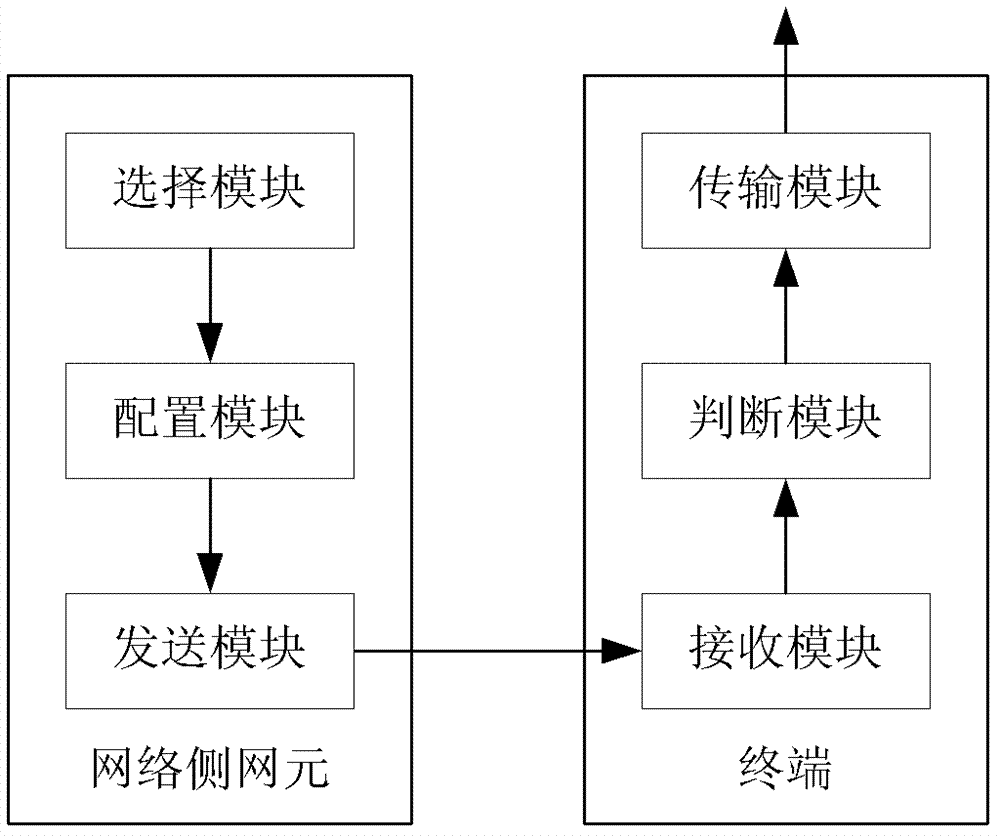Rank Adaptive Indication Method, Network Elements and Terminals in MIMO System
A self-adaptive, network-side technology, applied in transmission systems, digital transmission systems, diversity/multi-antenna systems, etc., can solve the problem of no way to indicate rank adaptation in MIMO systems, and achieve the effect of improving throughput and performance
- Summary
- Abstract
- Description
- Claims
- Application Information
AI Technical Summary
Problems solved by technology
Method used
Image
Examples
Embodiment 1
[0071] This embodiment describes how to perform rank adaptive indication, and the network side performs the following operations:
[0072] Selecting the transmission mode for the MIMO user as single-stream transmission or multi-stream transmission; according to the selection result, configuring the content or transmission mode carried by the Enhanced Rank Indication Channel (E-RICH) for the MIMO user; sending the E-RICH to MIMO users perform rank adaptive indication.
[0073] Specifically, a single-stream or multi-stream transmission is selected for the MIMO user according to the uplink channel conditions of the MIMO user. The multi-stream mode mentioned in this article—the n-stream mode, n≥2, that is to say, the multi-stream mode described herein can be a dual-stream mode, or more than two streams.
[0074] ●If single-stream transmission is selected for MIMO users, the transmission mode of E-RICH can be configured as follows:
[0075] Configure the E-RICH transmission mode ...
Embodiment 2
[0120] This embodiment uses a single user as an example to illustrate how to perform rank adaptive indication. In this embodiment, the transmission mode that the single user can select is single-stream and multi-stream, such as image 3 As shown in , network-side network elements (such as NodeB) perform the following operations:
[0121] Step 301, NodeB determines whether the UE adopts single-stream transmission or multi-stream transmission according to the uplink channel conditions of a certain MIMO user (hereinafter referred to as UE), if it is determined to adopt single-stream transmission, perform step 302, if it determines to adopt multi-stream transmission, perform step 303 ;
[0122] For example, the current UE has multiple antennas and has MIMO transmission capability. The NodeB estimates the uplink channel condition of the UE according to the currently received signals transmitted by the UE on multiple antennas, so as to determine whether the UE uses single stream or ...
application example 1
[0148] This example describes the process of multiplexing a total of 39 channels of E-RICH, E-RGCH and E-HICH of up to 13 uplink MIMO UEs into a single code channel, such as Figure 6 shown.
[0149] The network configures E-RICH for UE#n respectively n 、E-RGCH n and E-HICH n , respectively corresponding to different feature codes, n=1,2,...,13. The network can inform the user of the mapping between the signature and different information through high-level signaling, so that the user can decode the same channelization code but different signature information, so as to determine their own E-RICH, E-RGCH and E-HICH .
[0150] When the number of bits of the uplink MIMO rank adaptation indication information is 1, the E-RICH, E-RGCH and E-HICH channels share a 39-bit orthogonal code sequence. Since the uplink MIMO rank adaptation indication information is 1 bit, each Uplink MIMO users are assigned 3 feature codes (E-RICH, E-RGCH, and E-HICH are each assigned a feature code),...
PUM
 Login to View More
Login to View More Abstract
Description
Claims
Application Information
 Login to View More
Login to View More - R&D Engineer
- R&D Manager
- IP Professional
- Industry Leading Data Capabilities
- Powerful AI technology
- Patent DNA Extraction
Browse by: Latest US Patents, China's latest patents, Technical Efficacy Thesaurus, Application Domain, Technology Topic, Popular Technical Reports.
© 2024 PatSnap. All rights reserved.Legal|Privacy policy|Modern Slavery Act Transparency Statement|Sitemap|About US| Contact US: help@patsnap.com










